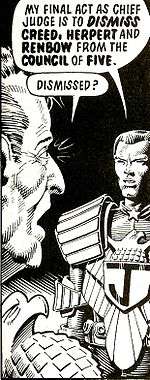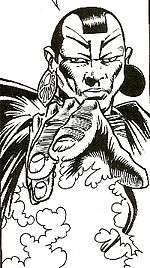Shojun the Warlord
| Shojun, Warlord of Ji | |
|---|---|
|
Drawn by Cam Kennedy | |
| Publication information | |
| Publisher | IPC Media (Fleetway) to 1999, thereafter Rebellion Developments |
| First appearance | 2000 AD #451 (1986) |
| Created by |
John Wagner and Alan Grant (writers) Cam Kennedy (artist) |
Shojun, Warlord of Ji was a fictional villain in the Judge Dredd comic strip in 2000 AD in 1986. He had powerful psionic abilities and attempted to take over the world.
Shojun came from the infamous Radlands of Ji (radioactive wastes in post-nuclear war China), home to some of the most dangerous individuals on the planet. He arrived in Mega-City One in 2108, and immediately warned the Judges not to interfere with his plans. His demonstration of his considerable powers began with the destruction of a building by will alone, resulting in over 250 deaths. He also had the ability to generate a psionic shield to protect himself, to stop bullets in mid-air, to attack people with blasts of psychic energy, to teleport himself and other people, and even to kill with a thought.
Impressed by his powers, Mega-City One's ruler, Chief Judge McGruder, thought it would be prudent to wait and see what Shojun intended to do before deciding on a course of action. In this matter she overruled the advice of Judge Dredd, whose immediate reaction was to request Shojun's instant assassination (using a laser since this would be too fast for Shojun to react to). Instead she ordered Dredd to place a bug in Shojun's premises to listen to his plans.
It was discovered that Shojun planned to raise the Seven Samurai, seven immensely powerful demons invulnerable to normal weapons, and use them to take over the world. Realising the gravity of the threat, McGruder finally authorised Shojun's assassination, but not in time. Teleporting to another location before the chief judge's orders could be carried out, Shojun raised the Seven Samurai and embarked on a murderous rampage. Justice Department surrounded the afflicted area with tanks and aerial assault vehicles, but even military firepower was completely ineffective against Shojun and his supernatural servants. In only a few minutes one hundred judges and three hundred civilians were slaughtered.
Although wounded in the encounter, Judge Dredd found one of the Samurai's shuriken (throwing stars) and realised that it alone was capable of penetrating Shojun's psionic shield. Although Shojun saw it coming, even he could not stop it and he was killed.
However, Shojun's death did not stop the Seven Samurai as Dredd had hoped. With the street judges helpless against this unprecedented threat, it fell to Psi Division (psychic judges) to defeat them. Judge Omar, head of Psi Division, destroyed the Seven Samurai, but at the cost of his own life, a price he knew in advance he would have to pay.
Aftermath

McGruder blamed herself for the massacre, realising that had she taken Dredd's advice and killed Shojun earlier then the catastrophe could have been averted. She announced her intention to resign as chief judge. This elicited a storm of protest from her fellow judges, who believed her to be an outstanding leader and who were therefore willing to overlook her responsibility for the debacle. However McGruder declared that she would not have tolerated such an error if it had been made by someone under her command, concluding "I can be no less severe on myself."
At her final meeting with the Council of Five, three of the city's most senior judges entreated her to reconsider. Instead she dismissed them from office, believing their leniency indicated poor judgement. Only Judge Shenker, Omar's successor as head of Psi-Division, concurred with her decision to resign, and consequently was the only member of the council to keep his seat.
Bibliography
The events described above were depicted in the following stories:
- Judge Dredd (both written by John Wagner):
- "The Warlord" (art by Cam Kennedy, in 2000 AD #451-455, 1986)
- "The Chief Judge Resigns" (art by Cliff Robinson, in 2000 AD #457, 1986)
Both stories have been reprinted, in the Judge Dredd Complete Casefiles vol. 9, as well as others.
External links
- Complete Casefiles vol. 9 at Amazon.com

